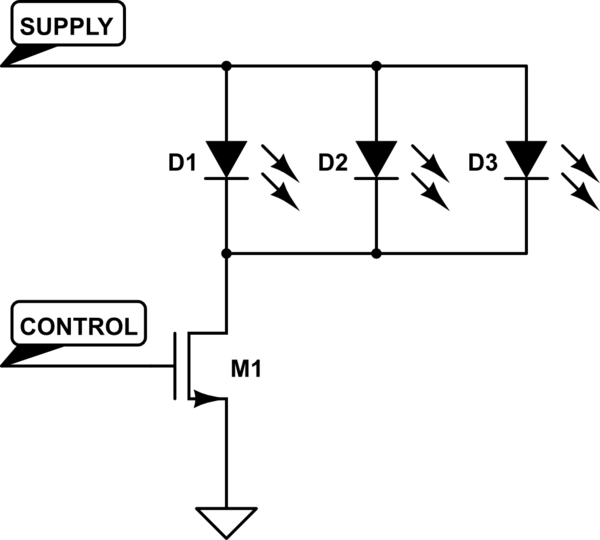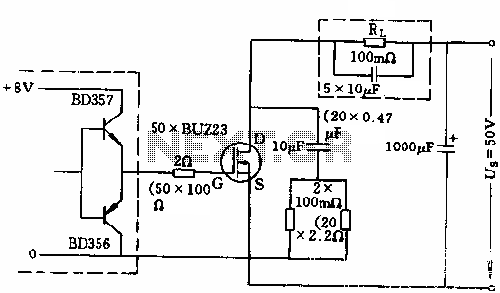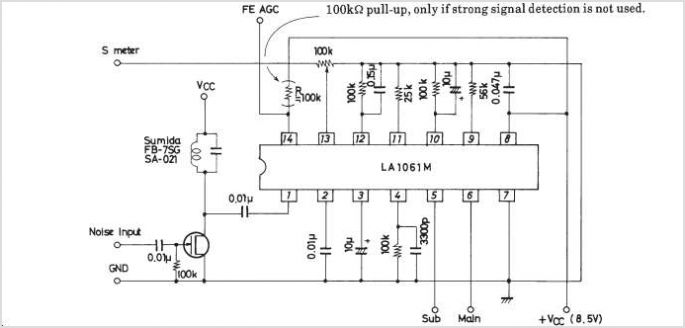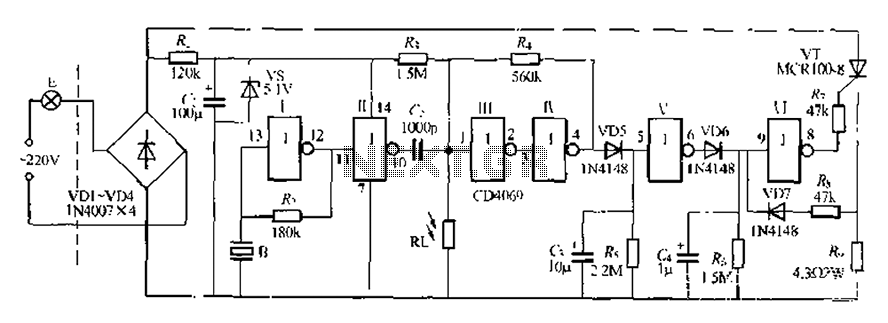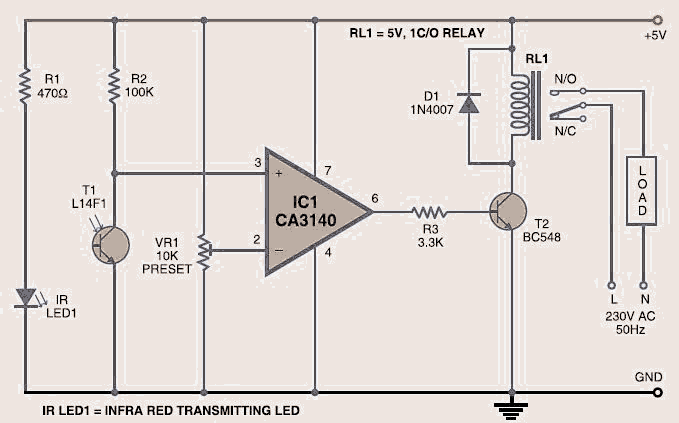
Touch Switch with 555
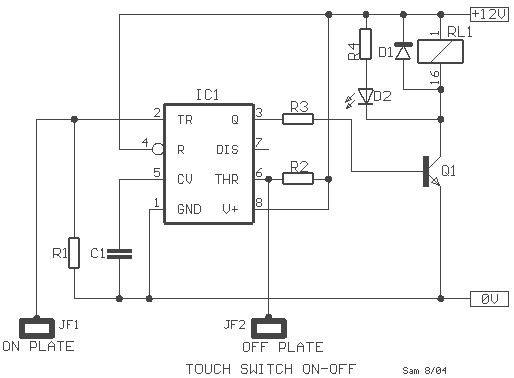
The modern mechanic switches are improved concerning old technology. We need, however, many times to replace some old switch or to check currents bigger than the durability of certain switches or simply we need something with a modern appearance. For these and different reasons, it is essential to update the circuit. It is simple in manufacture, and the materials used are readily available. This is based on the known 555 timer IC, which drives a relay whose contacts play the role of a switch. The metal surfaces can have any form desired, but they should be clean and positioned close to the circuit. In order to change the situation, it suffices to touch softly one of the two plates. Plate JF1 closes the contacts of RL1 [ON], while plate JF2 opens the contacts of RL1 [OFF]. The current that RL1 will handle depends on its contacts. The LED D2 turns on when the switch is in the ON position and the contacts of RL1 are closed.
The circuit utilizes a 555 timer integrated circuit (IC1) configured in a monostable mode, which allows it to respond to a momentary touch on either of the metal plates (JF1 or JF2). When a user touches plate JF1, it triggers the 555 timer, causing it to output a high signal that energizes the relay (RL1), closing its contacts and completing the circuit. This action allows current to flow through RL1, which can control a higher power load, depending on the relay's specifications.
The relay used (RL1) is a 12V type, chosen based on the required load specifications. The contacts of the relay can switch various devices or systems, providing a practical solution for applications that require switching capabilities beyond the limitations of traditional mechanical switches. The use of a 555 timer not only simplifies the design but also enhances reliability and durability compared to older technologies.
Resistor R1 (3.3MΩ) and capacitor C1 (10nF) form the timing components for the 555 timer, determining how long the output remains high after the touch is detected. Resistor R3 (10kΩ) and R4 (1kΩ) serve as pull-down and current limiting resistors, ensuring proper operation of the circuit and protecting the LED (D2) from excessive current.
The LED D2, a red 3 or 5mm type, provides a visual indication of the relay's status. It lights up when the relay is activated (contacts closed), signaling that the circuit is operational. The overall design emphasizes simplicity, cost-effectiveness, and ease of assembly, making it suitable for various applications where modern switching solutions are desired.The modern mechanic switches are improved concerning of old technology. We need however many times to replacement some old switch or to check currents bigger than the durability of certain switches or simple we need something with modern appearance. For he and different reasons is essential the up circuit. He is simple in the manufacture and the materials that use they exist everywhere. This based in the known 555, which drives a relay of which the contacts play the role of switch. The metal surfaces can have what form we want, but it should they are clean and near in the circuit. In order to it changes situation it suffices touch soft somebody from the two plates. Plate JF1 in order to the contacts of RL1 close [ON] or plate JF2 in order to the contacts of RL1 open [OFF]. The current that RL1 will check depended from his contacts. The Led D2 turns on when the switch they are in place ON and the contacts of RL1 closed. Part List R1-2=3.3M 1/4W 5% D1=1N4148 RL1=12V Relay [Your choise ] R3=10K 1/4W 5% D2= Red LED 3 or 5mm.
JF1-2=Metal Plate R4=1K 1/4W 5% Q1=BC547 C1=10nF 63V MKT 5% IC1=555 🔗 External reference
The circuit utilizes a 555 timer integrated circuit (IC1) configured in a monostable mode, which allows it to respond to a momentary touch on either of the metal plates (JF1 or JF2). When a user touches plate JF1, it triggers the 555 timer, causing it to output a high signal that energizes the relay (RL1), closing its contacts and completing the circuit. This action allows current to flow through RL1, which can control a higher power load, depending on the relay's specifications.
The relay used (RL1) is a 12V type, chosen based on the required load specifications. The contacts of the relay can switch various devices or systems, providing a practical solution for applications that require switching capabilities beyond the limitations of traditional mechanical switches. The use of a 555 timer not only simplifies the design but also enhances reliability and durability compared to older technologies.
Resistor R1 (3.3MΩ) and capacitor C1 (10nF) form the timing components for the 555 timer, determining how long the output remains high after the touch is detected. Resistor R3 (10kΩ) and R4 (1kΩ) serve as pull-down and current limiting resistors, ensuring proper operation of the circuit and protecting the LED (D2) from excessive current.
The LED D2, a red 3 or 5mm type, provides a visual indication of the relay's status. It lights up when the relay is activated (contacts closed), signaling that the circuit is operational. The overall design emphasizes simplicity, cost-effectiveness, and ease of assembly, making it suitable for various applications where modern switching solutions are desired.The modern mechanic switches are improved concerning of old technology. We need however many times to replacement some old switch or to check currents bigger than the durability of certain switches or simple we need something with modern appearance. For he and different reasons is essential the up circuit. He is simple in the manufacture and the materials that use they exist everywhere. This based in the known 555, which drives a relay of which the contacts play the role of switch. The metal surfaces can have what form we want, but it should they are clean and near in the circuit. In order to it changes situation it suffices touch soft somebody from the two plates. Plate JF1 in order to the contacts of RL1 close [ON] or plate JF2 in order to the contacts of RL1 open [OFF]. The current that RL1 will check depended from his contacts. The Led D2 turns on when the switch they are in place ON and the contacts of RL1 closed. Part List R1-2=3.3M 1/4W 5% D1=1N4148 RL1=12V Relay [Your choise ] R3=10K 1/4W 5% D2= Red LED 3 or 5mm.
JF1-2=Metal Plate R4=1K 1/4W 5% Q1=BC547 C1=10nF 63V MKT 5% IC1=555 🔗 External reference

